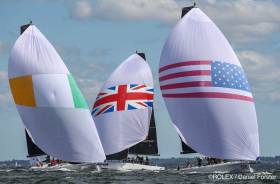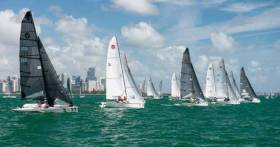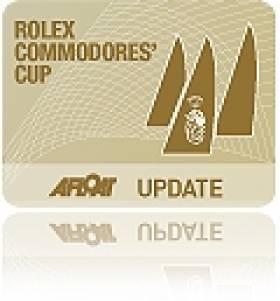Displaying items by tag: Anthony O Leary
Wicklow Designed IC37 is 'Perfect Fleet Racing Boat'
Ireland is on the International yacht racing stage this week thanks to triumphs on the water and off at last Saturday's Rolex New York Yacht Club Invitational Cup.
As Afloat reported previously, the Crosshaven, County Cork team led by Anthony O'Leary snatched the bronze medal from Canada in a superlative last day finish while the Kilbride, County Wicklow design team of Mark Mills is celebrating the success of its new IC37s used at the prestigious Big Apple event.
The Invitational Cup produced stunning racing across the full range of conditions for the Club’s fleet of 20 new Mills designed Melges IC37’s. This sixth edition of the biennial Corinthian championship was a true test of talent, teamwork and perseverance over four days and twelve races. After a strong early showing by the San Diego Yacht Club, the Royal Sydney Yacht Squadron came to the fore to win the event on the final day. Six-time participant Royal Cork Yacht Club won the last race to take the final podium placing.
The response to the new IC37 designs has been phenomenal: “A boat that was a surprise. Really technical and fun in all conditions.” Perhaps the highest compliment was made to designer Mark Mills on the lawn at Harbour Court after racing one day: “really the perfect fleet racing boat.” The remarkable spectrum of organisational talent on show by the NYYC to create the event, envisage a new class for it, have 20 of them built, run the racing, and host the competitors is unparalleled.
Royal Cork's O'Leary Tenth in Viper Pan-American Championship
Sailed from March 9-11 as part of Bacardi Miami Sailing Week the EFG Viper Pan-American Championship is the culmination of a year’s worth of qualifying regattas in Australia, Europe, and North America and attracted its regular Irish entry for the week long regatta in Florida.
Royal Cork's Anthony O'Leary, crewed by Ross McDonald from Howth Yacht Club and David Hassett from Cork Harbour (now living in the US) finished tenth in the 23–boat fleet.
A second in race five of the nine race series being the Irish boat's top score.
Commodores' Cup Celebration Dinner to be Held at Royal Cork
Team Ireland boats, Antix - Anthony O Leary, Marinerscove.ie - Dave Dwyer and Roxy 6 - Rob Davies and Andrew Creighton, will be represented on the night.
The dinner cost will be €30 and booking will be on first come/first served basis. Book with [email protected] or call 021 4831023.

























